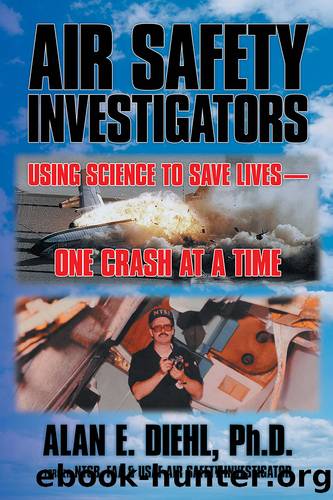Air Safety Investigators by Alan E. Diehl PhD

Author:Alan E. Diehl, PhD [Alan E. Diehl, Ph.D.]
Language: eng
Format: epub
ISBN: 9781479728954
Publisher: Xlibris US
Published: 2013-04-17T00:00:00+00:00
(Sketch by the Author)
Figure 3. What, How, Why Flowchart for the Downeast Crash.
We carefully reviewed these issues, and he was obviously pleased with my work. So I decided to inform him of the objections and threats that unnamed senior staffers were making about such matters. I obviously didnât want him surprised in the hearing with the press and cameras on hand.
Chairman King, smiled, and with his Boston brogue said, âThanks for the heads-up. Al, you just worry about the science, and let me handle those guys.â
The hearing on Downeast investigation was held on May 12, 1980, in the NTSB meeting room overlooking Independence Avenue, in Washington, DC. And right from the get-go, a senior employee asked to be recognized, saying several of the technical staffers were concerned about some of the highly speculative material contained in this draft report. In particular, the so-called âhuman performanceâ evidence seemed flimsy and needed to be deleted. Jim King, looked over at me, winked, and asked for an example.
This senior staffer took the bait. He opined, for instance, how the issue of the different colored engine instrument lights was irrelevant, since part 135 of the Federal Air Regulations required crew members to always have a working flashlight available. Therefore, these pilots didnât have to rely on those supposedly noisome engine lights.
Chairman King smiled and asked how a pilot could fly holding the yoke in one hand while manipulating the throttles with his other and still be able to shine his ârequiredâ flashlight on those engine instruments. The embarrassed staffer slumped down in his chair, never opening his mouth again. And my extensive human performance inputs stayed unmolested in the final report.
At the end of the board meeting, when the chairman and four members voted on the report, it was unanimously approved. The NTSB had reached its official conclusions on this accident. They issued their twenty-one findings, which fell into several general categories.65
These included several obvious items such as the crew descended below their MDA without having visual contact with the runway environment. It was the captainâs responsibility to monitor the aircraftâs progress, while watching for the runway. The first officer was weak on instrument flying skills and crew coordination procedures.
The board addressed cockpit ergonomic issues too. One finding specifically noted the problems with the mixed colors of cockpit engine instrument lights, while another criticized the design of the flap control.
Other findings addressed issues with the airlineâs management. These included pressures on pilots to bring aircraft back to Rockland, even if it meant descending below the MDA. And the companyâs inadequate training programs in general and its lack of crew resource management training in particular, were noted.
Board findings also criticized the FAAâs lack of surveillance on this airline, as well as their failure to follow up on complaints received of questionable company practices.
I was particularly thankful the board issued a finding noting the captain was suffering from job-related stress and chronic fatigue.
Not surprisingly, the boardâs determination of probable cause discussed the flight crewâs failure to arrest the aircraftâs descent on this nonprecision approach.
Download
This site does not store any files on its server. We only index and link to content provided by other sites. Please contact the content providers to delete copyright contents if any and email us, we'll remove relevant links or contents immediately.
Small Unmanned Fixed-wing Aircraft Design by Andrew J. Keane Andras Sobester James P. Scanlan & András Sóbester & James P. Scanlan(32763)
Navigation and Map Reading by K Andrew(5133)
Endurance: Shackleton's Incredible Voyage by Alfred Lansing(4718)
And the Band Played On by Randy Shilts(2165)
The Box by Marc Levinson(1965)
Top 10 Prague (EYEWITNESS TOP 10 TRAVEL GUIDES) by DK(1957)
Wild Ride by Adam Lashinsky(1951)
The Race for Hitler's X-Planes: Britain's 1945 Mission to Capture Secret Luftwaffe Technology by John Christopher(1837)
The One Percenter Encyclopedia by Bill Hayes(1811)
Trans-Siberian Railway by Lonely Planet(1725)
Girls Auto Clinic Glove Box Guide by Patrice Banks(1707)
Bligh by Rob Mundle(1676)
Looking for a Ship by John McPhee(1651)
Good with Words by Patrick Barry(1641)
Batavia's Graveyard by Mike Dash(1633)
TWA 800 by Jack Cashill(1625)
Fighting Hitler's Jets: The Extraordinary Story of the American Airmen Who Beat the Luftwaffe and Defeated Nazi Germany by Robert F. Dorr(1610)
Troubleshooting and Repair of Diesel Engines by Paul Dempsey(1578)
Ticket to Ride by Tom Chesshyre(1567)
